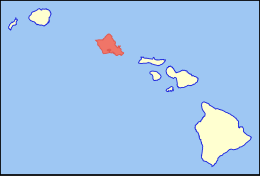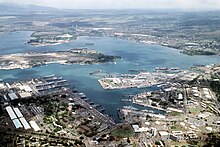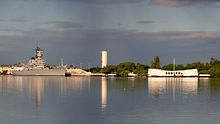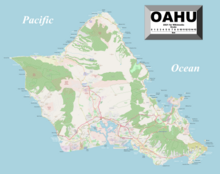| Nickname: Gathering Place | |
|---|---|
 | |
 | |
| Geography | |
| Location | 21°30′N 158°00′W / 21.5°N 158.0°W / 21.5; -158.0 |
| Area | 596.7 sq mi (1,545 km) |
| Area rank | 3rd largest Hawaiian Island |
| Highest elevation | 4,025 ft (1226.8 m) |
| Highest point | Kaʻala |
| Administration | |
| United States | |
| Symbols | |
| Flower | ʻilima |
| Color | Melemele (yellow) |
| Largest settlement | Honolulu |
| Demographics | |
| Population | 1,016,508 (2020) |
| Pop. density | 1,704/sq mi (657.9/km) |
Oʻahu (pronounced /oˈʔɐhu/, /oʊˈɑːhuː/, sometimes written Oahu for convenience) is the third-largest and most populated island of the Hawaiian Islands and of the U.S. state of Hawaii. The state capital, Honolulu, is on Oʻahu's southeast coast. The island of Oʻahu and the uninhabited Northwestern Hawaiian Islands constitute the City and County of Honolulu. In 2021, Oʻahu had a population of 995,638, up from 953,207 in 2010 (approximately 70% of the total 1,455,271 population of the Hawaiian Islands, with approximately 81% of those living in or near the Honolulu urban area).
Oʻahu is 44 miles (71 km) long and 30 miles (48 km) across. Its shoreline is 227 miles (365 km) long. Including small associated islands such as Ford Island plus those in Kāneʻohe Bay and off the eastern (windward) coast, its area is 596.7 square miles (1,545.4 km), making it the 20th-largest island in the United States.
Well-known features of Oʻahu include Waikīkī, Pearl Harbor, Diamond Head, Hanauma Bay, Kāneʻohe Bay, Kailua Bay, and the North Shore.
Name
The Island of Oʻahu in Hawaii is often nicknamed (or translated as) "The Gathering Place". The translation of "gathering place" was suggested as recently as 1922 by Hawaiian Almanac author Thomas Thrum. Thrum possibly ignored or misplaced the ʻokina because the Hawaiian phrase "ʻo ahu" could be translated as "gathering of objects" (ʻo is a subject marker and ahu means "to gather"). The term Oʻahu has no other confirmed meaning in Hawaiian.
History
See also: History of Hawaii and Hawaii § History

It is uncertain when Oʻahu was first settled by humans. Early archaeological studies suggested that Polynesian explorers from the Marquesas may have arrived as early as the 3rd century A.D., possibly with a second wave arriving from Tahiti around 1100 A.D. However, more modern analyses indicate that the first settlers probably arrived around 900–1200 A.D.
The first great king of Oʻahu was Maʻilikūkahi, the lawmaker, who initiated a 304-year dynasty of monarchs. Kualiʻi was the first of the warlike kings and was succeeded by his sons. In 1773, the throne fell upon Kahahana, the son of Elani of Ewa.
On January 19, 1778, Oʻahu was the first of the Hawaiian Islands to be sighted by Captain James Cook during his third voyage of discovery. This was the first recorded encounter of the Hawaiian Islands by non-Polynesian people. Cook bypassed Oʻahu, landing instead at Kauai before continuing his original mission to explore the coast of North America. The next year, on February 27, 1779, Cook's second in command, Captain Charles Clerke, became the first recorded non-Polynesian to visit Oʻahu when he landed at Waimea Bay. Earlier that month, Cook had been killed at Kealakekua Bay on the island of Hawaii when a dispute with the local people turned violent. Clerke's visit to Oʻahu was brief and the expedition's two ships left Waimea Bay the same day after finding it difficult to obtain fresh water.
At the time of Cook's visit, the Hawaiian Islands were divided among several warring chiefdoms. In 1783, Kahekili II, king of the island of Maui, conquered Oʻahu. He then made his son, Kalanikūpule, king of Oʻahu turning it into a puppet state. Kalanikūpule was later defeated in the Battle of Nuʻuanu in 1795 by Kamehameha I who then founded the Kingdom of Hawaii. The Hawaiian islands were not fully unified until King Kaumualiʻi surrendered the islands of Kauai and Niihau in 1810.
By the late 18th century, Waikīkī was a major settlement on Oʻahu, serving as Kahekili II's residence after 1783. However, as trade with foreigners intensified, the nearby town of Honolulu came to eclipse it in size and importance due to its more accessible harbor.In 1845, Kamehameha III moved his capital to Honolulu from Lahaina on the island of Maui. Later, King Kalākaua had a modern residence built in Honolulu for the royal family – the ʻIolani Palace which still stands as the only royal palace on American soil. In January, 1893, a group of leading American businessmen took up arms near ʻIolani Palace and, along with US Marines from the USS Boston that landed in Honolulu harbor, launched a successful coup d'état against Queen Liliʻuokalani. The insurgents abolished the monarchy and established the Republic of Hawaii, which later successfully lobbied the US government for annexation to the US.
On the morning of December 7, 1941, the Imperial Japanese Navy launched a surprise attack on Pearl Harbor, Oʻahu, bringing the United States into World War II. The attack was aimed at destroying the American will to fight and forcing the US to sue for peace. They attacked the Pacific Fleet of the United States Navy and its defending Army Air Forces and Marine Air Forces. The attack damaged or destroyed 12 American warships, destroyed 188 aircraft, and killed 2,335 American servicemen and 68 civilians (of those, 1,177 were the result of the destruction of the USS Arizona alone).
After World War II, Oʻahu became a tourism and shopping destination with more than five million visitors per year, mainly from the contiguous United States and Japan.
Geography and climate

Like all other Hawaiian Islands, Oʻahu was formed from the volcanism associated with the Hawaii hotspot; it started to grow from the sea floor 4 million years ago. Today, the island is composed of the remnants of two extinct and extensively eroded shield volcanoes: the Waiʻanae and Koʻolau Ranges, with a broad valley or saddle between them. The highest point is Kaʻala in the Waiʻanae Range, rising to 4,003 feet (1,220 m) above sea level.
Oʻahu is known for having the longest rain shower in recorded history. Kāneʻohe Ranch reported 247 straight days of rain from August 27, 1993, to April 30, 1994. The average temperature in Oʻahu is around 70–85 °F (21–29 °C). The island is the warmest from June through October. The winter is cooler, but still warm, with an average temperature of 68–78 °F (20–26 °C).
| ||||||||||||||||||||||||||||||||||||||||||||||||||||||||||||||||||||||||||||||||||||||||||||||||||||||||||||||||||||||||||||
Tourism
Oʻahu, along with the rest of the State of Hawaii, relies on tourism as a driving force of the local economy. Popular tourists attractions include beaches such as Ala Moana Beach, Hanauma Bay, Kāneʻohe Bay, Ko Olina Beach Park, Waikīkī Beach, among others. Other tourist attractions include Ala Moana Center, Bishop Museum, the Honolulu Museum of Art, ʻIolani Palace, and Kualoa Ranch.
 Hanauma Bay
Hanauma Bay
-
 Ko'Olina white sand lagoon
Ko'Olina white sand lagoon
-
Lanikai Beach
-
Downtown Honolulu
-
Waikīkī Beach is one of the most well-known beaches in the world
-
 Valley of the Temples Memorial Park near the island's eastern shore
Valley of the Temples Memorial Park near the island's eastern shore
-
 Jellyfish swim in a tank at Waikīkī Aquarium
Jellyfish swim in a tank at Waikīkī Aquarium
-
Mokoliʻi island, also known as Chinaman's Hat, offshore of Kualoa Valley
-
 Nuʻuanu Pali of the Koʻolau mountain
Nuʻuanu Pali of the Koʻolau mountain
-
 Helicopter view of Magic Island
Helicopter view of Magic Island
Notable people
See also: Category:People from Oʻahu- Benny Agbayani, professional baseball player
- Keiko Agena, actor
- Gabe Baltazar, clarinet and saxophone player
- Nicole Kidman Academy Award-winner actress
- Alexandria Boehm, scientist
- Darin Brooks, actor, writer, producer
- Max Holloway, MMA Fighter, Former UFC Featherweight Champion
- Angelique Cabral, actor
- Tia Carrere, actor
- Brian Ching, Major League Soccer
- Dennis Chun, actor (Hawaii Five-0), son of Kam Fong
- Bryan Clay, Olympic decathlete 2008
- Scott Crary, film director and producer
- Auliʻi Cravalho, actor, singer
- Mark Dacascos, actor
- Caitlin Doughty, mortician, author and YouTube personality
- Diana Ewing, actor
- Sid Fernandez, baseball
- Maile Flanagan, actor
- Kam Fong, actor
- Lauren Graham, actor
- Erin Gray, actor
- Brian Grazer, Oscar-winning film and television producer
- Coco Ho, pro surfer
- Don Ho, singer
- Kelly Ann Hu, actor
- Carrie Ann Inaba, dancer, actor, musician
- Daniel Inouye, US Senator, Medal of Honor recipient
- Jack Johnson, musician, folk-rock singer-songwriter
- Duke Kahanamoku, pro swimmer, surfer, sheriff
- Samuel Kamakau, historian
- Israel Kamakawiwo'ole, musician
- Maxim Knight, actor
- Olin Kreutz, football player Chicago Bears
- Clyde Kusatsu, actor
- Brook Lee, model and co-host of television talk showIt's a Hawaii Thing on OC 16
- Teri Ann Linn, actor
- Jack Lord, actor
- Marcus Mariota, NFL football player, Philadelphia Eagles
- Markiplier (Mark Edward Fischbach), Internet personality, video game commentator
- Bruno Mars, singer-songwriter, record producer, musician
- Julie McCullough, actor
- Zack Merrick, drummer in American rock band All Time Low
- Bette Midler, singer, actor, comedian
- Jason Momoa, actor
- Carissa Moore, pro surfer, olympian
- Tahj Mowry, actor
- Don Muraco, professional wrestler
- Jamie O'Brien, surfer
- Barack Obama, 44th President of the United States
- Ellison Onizuka, NASA astronaut, STS-51-C, STS-51-L, Space Shuttle Challenger disaster
- Noelani Pantastico, ballet dancer
- Janel Parrish, actor, singer
- Kelly Preston, actor
- Maggie Q, actor
- Jonah Ray, actor, comedian, writer
- Makua Rothman (born 1984), world champion surfer
- Anthony Ruivivar, actor
- Jesse Sapolu, retired football player, San Francisco 49ers
- Garret T. Sato, actor
- Amanda Schull, actor
- John John Florence, professional surfer
- James Shigeta, actor
- Jake Shimabukuro, ʻukulele player
- Karen Steele, actor
- Don Stroud, actor
- Tua Tagovailoa, NFL football player, Miami Dolphins
- Ronald Takaki, academic, historian, ethnographer, and author
- Akebono Tarō, sumo wrestler
- Kristi Tauti, professional figure competitor and fitness model
- Manti Te'o, NFL football player, Los Angeles Chargers
- Paul Theroux, author
- Michelle Wie West, golf LPGA
- Taylor Wily, actor
- Kirby Wright, poet and writer
- Keone Young, actor
See also
- Honolulu Volcanics
- National Register of Historic Places listings in Oahu
- Oahu Ice and Cold Storage Company
References
- Nichols, William D.; Shade, Patricia J.; Hunt, Charles D. (1996). Professional Paper (Report). doi:10.3133/pp1412a. hdl:2027/mdp.39015040694906.
- "Northwest Hawaiian Islands". School of Ocean Science and Technology.
- "US Census Bureau". Archived from the original on October 24, 2021. Retrieved December 9, 2021.
- "US Census Bureau". census.gov.
- "Table 5.08 – Land Area of Islands: 2000" (PDF). State of Hawaii. 2004. Archived from the original (PDF) on March 9, 2013. Retrieved July 23, 2007.
- Pukui, Mary Kawena (December 1976). Place Names of Hawaii. University of Hawaii Press. ISBN 0-8248-0524-0.
- Van, James (2010). Ancient Sites of Oahu: A Guide to Archaeological Places of Interest. Bishop Museum Pr. Page 5. ISBN 978-1581780956.
- Buck, Peter H. (1938). Vikings of the Sunrise. New York: Frederick A. Stokes Company. pp. 257–259.
- Kirch, Patrick (2011). "When did the Polynesians Settle Hawaii? A review of 150 years of scholarly inquiry". Hawaiian Archaeology. 12: 3–27.
- Cook, James (1821). The Three Voyages of Captain Cook Round the World. Vol. VI. Being the Second of the Third Voyage. London. p. 176.
- Hough, Richard (1997). Captain James Cook: a biography. New York: Norton. pp. 341–354. ISBN 978-0-393-31519-6.
- King, James (1821). The Three Voyages of Captain Cook Round the World. Vol. VII. Being the Third of the Third Voyage. London. pp. 80–82.
- ^ Kuykendall, Ralph S. (1938). The Hawaiian Kingdom 1778-1854 Vol 1 Foundation and Transformation. Honolulu: University of Hawaii Press.
- Staton, Ron (March 19, 2004). "Oahu: The Iolani, America's only royal palace". Seattle Times. Retrieved March 3, 2016.
- Burr, Lawrence; Palmer, Ian; White, John (2011). US Cruisers 1883–1904: The birth of the steel navy. Bloomsbury Publishing. p. 35. ISBN 978-1-84603-858-7. OCLC 1021805683.
- "Pearl Harbor Fact Sheet" (PDF).
- "The Pearl Harbor Attack, 7 December 1941 – Overview". NHHC. Retrieved November 30, 2023.
- "YTD Visitors by Country By Month by MMA" (PDF).
- Hawaiian Volcano Observatory (January 14, 2016). "A geologic tour of the Hawaiian Islands: O'ahu". usgs.gov.
- Juvik, Sonia P.; Juvik, James O.; Paradise, Thomas R. (1998). Atlas of Hawai'i. University of Hawaii Press. p. 7. ISBN 978-0-8248-2125-8.
- "Table 5.11 – Elevations of Major Summits" (PDF). State of Hawaii. 2004. Archived from the original (PDF) on March 9, 2013. Retrieved July 23, 2007.
- "NASA Earth Observations Data Set Index". NASA. Archived from the original on August 6, 2013. Retrieved January 30, 2016.
- "Fact Sheet: Benefits of Hawai'i's Tourism Economy" (PDF). >Hawaii Tourism Authority. December 2019.
External links
- [REDACTED] Media related to Oahu at Wikimedia Commons
 Oahu travel guide from Wikivoyage
Oahu travel guide from Wikivoyage
| Islands, municipalities, and communities of Honolulu County, Hawaii, United States | |||||
|---|---|---|---|---|---|
| County seat: Honolulu | |||||
| CDPs |
|  | |||
| Other communities | |||||
| Government |
| ||||
| State of Hawaii | |
|---|---|
| Honolulu (capital) | |
| Topics | |
| Society | |
| Main islands | |
| Northwestern Islands | |
| Notable communities | |
| Counties | |
| Pre-statehood history | |
